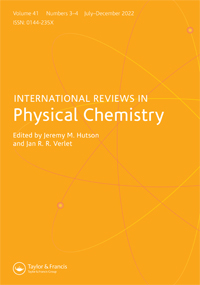Solvation of ions in helium
IF 2.5
2区 化学
Q3 CHEMISTRY, PHYSICAL
引用次数: 23
Abstract
We review the solvation of atomic, molecular or cluster ions in HNDs. After briefly discussing the properties of snowballs in bulk helium we consider experimental conditions for the efficient synthesis of charged, doped HNDs. We show that the cluster ions observed in conventional mass spectrometers originate from fission of highly charged HNDs. The ionization threshold of HNDs doped with alkalis reveals the minimum cluster size required for full immersion. The abundance distributions of He X ions frequently reveal local anomalies or magic numbers. We demonstrate that the abundance is approximately proportional to the evaporation energy. Observed and calculated magic numbers will be compiled, including data for ions solvated in molecular hydrogen. Alternative methods to forming He X that do not employ HNDs will be summarized. Electronic excitation spectra of C and polycyclic aromatic hydrocarbon ions reveal the properties of the helium adsorption layer in quantitative detail. Next we discuss theoretical efforts to describe the interaction between ions and helium. We close with summarizing the size dependence of physical quantities computed for atomic alkali and alkaline earth cations in helium, such as binding energy, superfluid fraction, structural order, radial density profiles, and the existence of first and higher solvation shells.离子在氦中的溶剂化
综述了HNDs中原子、分子或簇离子的溶剂化。在简要讨论了大块氦中雪球的性质之后,我们考虑了有效合成带电掺杂HNDs的实验条件。我们表明,在传统的质谱仪中观察到的簇离子起源于高电荷HNDs的裂变。碱掺杂HNDs的电离阈值揭示了完全浸没所需的最小簇大小。氦X离子的丰度分布经常显示局部异常或幻数。我们证明了丰度与蒸发能近似成正比。观察和计算的幻数将被汇编,包括离子溶化在氢分子中的数据。将总结不使用HNDs的形成He X的替代方法。C和多环芳烃离子的电子激发光谱定量详细地揭示了氦吸附层的性质。接下来我们讨论描述离子和氦之间相互作用的理论努力。最后总结了氦中原子碱和碱土阳离子的物理量的大小依赖性,如结合能、超流分数、结构顺序、径向密度分布以及第一层和更高层溶剂化壳的存在。
本文章由计算机程序翻译,如有差异,请以英文原文为准。
求助全文
约1分钟内获得全文
求助全文
来源期刊
CiteScore
14.20
自引率
1.60%
发文量
5
审稿时长
1 months
期刊介绍:
International Reviews in Physical Chemistry publishes review articles describing frontier research areas in physical chemistry. Internationally renowned scientists describe their own research in the wider context of the field. The articles are of interest not only to specialists but also to those wishing to read general and authoritative accounts of recent developments in physical chemistry, chemical physics and theoretical chemistry. The journal appeals to research workers, lecturers and research students alike.

 求助内容:
求助内容: 应助结果提醒方式:
应助结果提醒方式:


